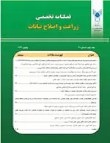Correlation, regression and cluster analysis for yield and yield components of wheat under deficit irrigation condition and spraying phosphorus
Author(s):
Abstract:
The relationships of some wheat traits and theirs direct and indirect influence on the grain yield (GY) were investigated. In base of important of subject this research conducted in form of factorial in based on random complete blocks design with four replication in research field farm of Islamic Azad University of Karaj branch in 2010-2011. Experimental treatments including: Low irrigation in three levels (Normal irrigation (NI)، Non irrigation from stem elongation to anthesis (NI1)، Non irrigation from anthesis to maturity (NI2)) and phosphorous spraying in four density: 0، 4، 6، 8 kg/ha from source of Potassium de-hydrogen Phosphate (KH2PO4). According to results observed significant correlation (α = 0. 01) between GY and Biomass (TDW)، 1000 grain weight (TGW)، and harvest index (HI). In stepwise regression method under NI condition، some traits including Biomass &harvest index and under NI1 condition، grain number per ear (GNE)، ear number per m2 (EN)، plant height (PH) & unit grain weight (UGW) and under NI2 condition some traits including biomass (TDW)، harvest index (HI)، 1000 grain weight (TGW) & fertile spikelet number (NFS) remained in final model R2 was equal to 0. 97، 0/99 and 0. 997، respectively. Path analysis results showed that the biomass has a highest direct and positive effect under normal irrigation (1. 511) and NI2 condition (0. 828)، on GY، but in NI1 condition، highest direct and positive effect related to grain number per ear (GNE) trait (1/231). Among the Other traits، grain number per ear (0/849) trait، has a highest indirect effect on GY. Totally designated increasing of Biomass and grain number per ear traits are important way for increasing of GY trait.
Keywords:
Language:
Persian
Published:
Journal of Agronomy and Plant Breeding, Volume:10 Issue: 4, 2015
Pages:
43 to 55
https://www.magiran.com/p1496679


